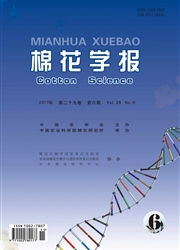

 中文摘要:
中文摘要:
对已构建的黄萎病菌诱导下陆地棉抗病品种冀棉20SSH文库的800个阳性克隆进行了检测和筛选,将插入片段大于400bp的克隆测序,获得非重复克隆的EST序列203条。通过同源比对和序列相似性分析,共有170条ESTs与已知基因同源。将获得的ESTs按比对推测的功能进行分类,主要包括代谢、防御、胁迫、信号转导、核糖体蛋白、细胞结构、细胞发育、能量、渗透调节以及蛋白质合成与分解等10类。功能未知的ESTs也占有不小比例,达16.26%。共发现66条与抗病相关的ESTs,约占全部ESTs的33%。这些与抗病相关的同源序列涉及到与防御、次生代谢、胁迫及信号转导有关的基因,表明当黄萎病菌侵染棉花后,植物体内发生了一系列的反应.抗黄萎病是一个多途径作用的复杂过程。
 英文摘要:
英文摘要:
In the study, we screened the suppression subtractive hybridization (SSH) library of resistant upland cotton cultivar, named Jimian20 infected by Verticillium dahliae. More than 400 bp fragments were selected and sequenced fi'om 800 positive clones. The results showed that 203 ESTs were unique. ESTs similarity analysis indicated that 170 ESTs were homologous to the known genes. According to the function of putative proteins, these homologous sequences were related to ten kinds of roles as reported, including metabolism, defense, stress, signal transduction, ribosomal protein, cell structures, cell development, energy, osmotic adjustment, protein synthesis and decomposition and so on. ESTs of unknown function were also a large proportion, accounting for 16.26%. Sixty-six ESTs were related to disease-resistance genes, accounting for 33% of all ESTs. Most of them had high similarity to the defense, secondary metabolites, stress and signal transduction. The above results would be helpful to understand the molecular mechanisms of Verticillium resistance in cotton.
 同期刊论文项目
同期刊论文项目
 同项目期刊论文
同项目期刊论文
 期刊信息
期刊信息
